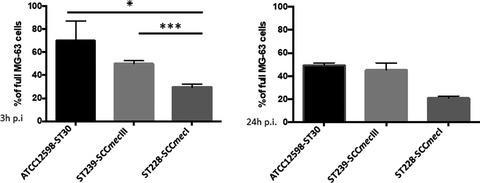当前位置:
X-MOL 学术
›
Microbiologyopen
›
论文详情
Our official English website, www.x-mol.net, welcomes your
feedback! (Note: you will need to create a separate account there.)
Staphylococcus aureus ST228 and ST239 as models for expression studies of diverse markers during osteoblast infection and persistence
MicrobiologyOpen ( IF 3.9 ) Pub Date : 2021-05-01 , DOI: 10.1002/mbo3.1178 Dafne Bongiorno 1 , Nicolò Musso 2 , Giuseppe Caruso 3 , Lorenzo Mattia Lazzaro 1 , Filippo Caraci 3, 4 , Stefania Stefani 1 , Floriana Campanile 1
MicrobiologyOpen ( IF 3.9 ) Pub Date : 2021-05-01 , DOI: 10.1002/mbo3.1178 Dafne Bongiorno 1 , Nicolò Musso 2 , Giuseppe Caruso 3 , Lorenzo Mattia Lazzaro 1 , Filippo Caraci 3, 4 , Stefania Stefani 1 , Floriana Campanile 1
Affiliation

|
The ability of S. aureus to infect bone and osteoblasts is correlated with its incredible virulence armamentarium that can mediate the invasion/internalization process, cytotoxicity, membrane damage, and intracellular persistence. We comparatively analyzed the interaction, persistence, and modulation of expression of selected genes and cell viability in an ex vivo model using human MG‐63 osteoblasts of two previously studied and well‐characterized S. aureus clinical strains belonging to the ST239‐SCCmecIII‐t037 and ST228‐SCCmecI‐t041 clones at 3 h and 24 h post‐infection (p.i). S. aureus ATCC12598 ST30‐t076 was used as a control strain. Using imaging flow cytometry (IFC), we found that these strains invaded and persisted in MG‐63 osteoblasts to different extents. The invasion was evaluated at 3 h p.i and persistence at 24 h p.i., in particular: ATCC12598 internalized in 70% and persisted in 50% of MG‐63 cells; ST239‐SCCmecIII internalized in 50% and persisted in 45% of MG‐63 cells; and ST228‐SCCmecI internalized in 30% and persisted in 20% of MG‐63 cells. During the infection period, ST239‐III exerted significant cytotoxic activity resulting from overexpression of hla and psmA and increased expression of the genes involved in adhesion, probably due to the release and re‐entry of bacteria inside MG‐63 cells at 24 h p.i. The lower invasiveness of ST228‐I was also associated with non‐cytotoxic activity inside osteoblasts. This clone was unable to activate sufficient cellular reaction and succumbed inside MG‐63 cells. Our findings support the idea of considering new strategies, based on a translational approach—eukaryotic host–pathogen interaction (EHPI)—and to be applied on a large scale, to predict S. aureus /osteoblast interaction and treat bone infections. Such strategies rely on the study of the genetic and biochemical basis of both pathogen and host.
中文翻译:

金黄色葡萄球菌 ST228 和 ST239 作为成骨细胞感染和持续过程中多种标志物表达研究的模型
的能力的金黄色葡萄球菌感染的骨和成骨细胞是其令人难以置信的毒力相关的医疗设备可以介导的入侵/内化过程中,细胞毒性,膜损伤和细胞内的持久性。我们使用人类 MG-63 成骨细胞的两种先前研究过且特征明确的 ST239-SCC mec III金黄色葡萄球菌临床菌株,在离体模型中比较分析了选定基因的表达和细胞活力的相互作用、持续性和调节-t037 和 ST228-SCC mec I-t041 克隆在感染后 3 小时和 24 小时 (pi)。金黄色葡萄球菌ATCC12598 ST30-t076 用作对照菌株。使用成像流式细胞术 (IFC),我们发现这些菌株不同程度地侵入并持续存在于 MG-63 成骨细胞中。在感染后 3 小时评估侵袭并在感染后 24 小时持续,特别是:ATCC12598 在 70% 内化并在 50% MG-63 细胞中持续存在;ST239-SCC mec III 内化率为 50%,并在 45% 的 MG-63 细胞中持续存在;ST228-SCC mec I 内化率为 30%,并在 20% 的 MG-63 细胞中持续存在。在感染期间,由于hla和psm 的过度表达,ST239-III 发挥了显着的细胞毒活性A 和粘附相关基因的表达增加,可能是由于细菌在感染后 24 小时内释放和重新进入 MG-63 细胞内 ST228-I 的较低侵袭性也与成骨细胞内的非细胞毒性活性有关。该克隆无法激活足够的细胞反应并在 MG-63 细胞内死亡。我们的研究结果支持考虑基于转化方法——真核宿主 - 病原体相互作用 (EHPI)——的新策略的想法,并大规模应用,以预测金黄色葡萄球菌/成骨细胞相互作用和治疗骨感染。这些策略依赖于对病原体和宿主的遗传和生化基础的研究。
更新日期:2021-05-02
中文翻译:

金黄色葡萄球菌 ST228 和 ST239 作为成骨细胞感染和持续过程中多种标志物表达研究的模型
的能力的金黄色葡萄球菌感染的骨和成骨细胞是其令人难以置信的毒力相关的医疗设备可以介导的入侵/内化过程中,细胞毒性,膜损伤和细胞内的持久性。我们使用人类 MG-63 成骨细胞的两种先前研究过且特征明确的 ST239-SCC mec III金黄色葡萄球菌临床菌株,在离体模型中比较分析了选定基因的表达和细胞活力的相互作用、持续性和调节-t037 和 ST228-SCC mec I-t041 克隆在感染后 3 小时和 24 小时 (pi)。金黄色葡萄球菌ATCC12598 ST30-t076 用作对照菌株。使用成像流式细胞术 (IFC),我们发现这些菌株不同程度地侵入并持续存在于 MG-63 成骨细胞中。在感染后 3 小时评估侵袭并在感染后 24 小时持续,特别是:ATCC12598 在 70% 内化并在 50% MG-63 细胞中持续存在;ST239-SCC mec III 内化率为 50%,并在 45% 的 MG-63 细胞中持续存在;ST228-SCC mec I 内化率为 30%,并在 20% 的 MG-63 细胞中持续存在。在感染期间,由于hla和psm 的过度表达,ST239-III 发挥了显着的细胞毒活性A 和粘附相关基因的表达增加,可能是由于细菌在感染后 24 小时内释放和重新进入 MG-63 细胞内 ST228-I 的较低侵袭性也与成骨细胞内的非细胞毒性活性有关。该克隆无法激活足够的细胞反应并在 MG-63 细胞内死亡。我们的研究结果支持考虑基于转化方法——真核宿主 - 病原体相互作用 (EHPI)——的新策略的想法,并大规模应用,以预测金黄色葡萄球菌/成骨细胞相互作用和治疗骨感染。这些策略依赖于对病原体和宿主的遗传和生化基础的研究。









































 京公网安备 11010802027423号
京公网安备 11010802027423号